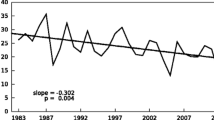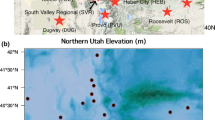Abstract
In order to study the temporal and spatial variation of fog days in Iran, the data of 115 synoptic meteorological stations have been analyzed for years 1960–2005. The results revealed that different types of fogs form all over the country, apart from central areas of Iran that are located in the big dessert of Iran. Advection fogs are common in the south coast (Persian Gulf) and north coastal (Caspian Sea) regions. Upslope fogs form in the mountainous areas of the northwest and north parts of Iran. This study shows no height dependence relationship on fog days for all types of fogs in overall. The trend analysis of fog days during the last 20 years shows some significant negative and positive trends. The frequency of advection fogs shows positive trends and most upslope fogs show negative trends. The results show that there are suitable places for fog collection projects in the north and south coastal regions during the year, especially in cold months.





Similar content being viewed by others
References
Acosta, Baladon A.N., Agricultural uses of occult precipitation (Ornex, France 1995).
Al Fenadi, Y.Sh. (2001), fog studies in North Libia, 2nd International conference on fog and fog collection, St. John’s, Canada, July 15-20, 2001, pp. 411–412).
American Meteorological Society, Glossary of Meteorology (Boston, 2000).
Esfandiarnejad A., and Ahangar R., and Kamalian U.R., and Sangchouli T.(2010), Feasibility studies for water harvesting from fog and atmospheric moisture in Hormozgan coastal zone (south of Iran), 5th International Conference on Fog, Fog Collection and Dew, Munster, Germany, 25–30 July 2010.
IRIMO, Meteorological Yearbook (Tehran, Iran, 2007).
Schemenauer, R.S. and P. Joe (1989) The collection efficiency of a massive fog collector. Atmos. Res., 24, 53–69.
Schemenauer, R.S. and P. Cereceda (1991), Fog water collection in arid coastal locations. Ambio, 20 (7), 303–308.
Schemenauer, R.S. and P. Cereceda (1994) A proposed standard fog collector for use in high elevation regions. J. Appl. Meteor., 33, 1313–1322.
Schemenauer R. and Cereceda P. (1997) Fog Collection, Tiempo, Issue 26 Dec.
Werner Eugster (2008), fog research, DIE ERDE 139(1-2), Zurich, pp. 1–10.
Acknowledgments
Here I would like to thank Dr. Robert Schemnauer from Environment Canada for his opinions in preparing this paper, Ian Bell from the Australian Bureau of Meteorology and two anonymous reviewers for their kind improvements in preparing this paper. I also would like to thanks Nooshin Mohammadian from I.R. of Iran Meteorological Organization for preparing maps.
Author information
Authors and Affiliations
Corresponding author
Rights and permissions
About this article
Cite this article
Rahimi, M. Analyzing the Temporal and Spatial Variation of Fog Days in Iran. Pure Appl. Geophys. 169, 1165–1172 (2012). https://doi.org/10.1007/s00024-011-0326-y
Received:
Revised:
Accepted:
Published:
Issue Date:
DOI: https://doi.org/10.1007/s00024-011-0326-y




